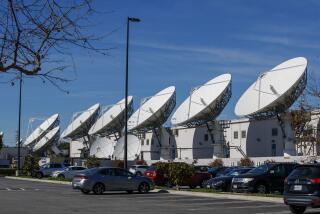AT&T; BREAKUP II : OUTLOOK: BELL LABS : Restructuring Won’t Affect Role of Research and Development Arm : The science unit, one of AT&T;’s crown jewels, will become part of the new communications equipment company. No further cuts are expected.
- Share via
NEW YORK — The 6,500 scientists employed at the world-famous AT&T; Bell Laboratories will not see their jobs further threatened with the announcement that their parent company will split itself into three independent companies, analysts said.
The research and development unit, one of the crown jewels of AT&T;, will become part of the communications equipment company that will be created by the phone company’s voluntary breakup announced Wednesday.
Some of the laboratory’s research groups that focus on communications services will be transferred to the main company, which will retain the AT&T; name, said Chairman and Chief Executive Robert E. Allen. “We will establish an AT&T; Labs, which will include those people who today are part of Bell Labs who are working on communications services, systems and products,” he said.
Otherwise, the R&D; unit will remain intact with no further cuts expected.
“This move is about restructuring, not about labor force reduction,” AT&T; spokeswoman Kathleen Fitzgerald said.
The size and scope of Bell Labs has shrunk considerably since 1984, when the federal government forced the AT&T; breakup that created the so-called Baby Bells. But analysts said they do not expect any more cuts at the laboratory.
“Bell Labs has had a good 11 years of restructuring already,” said Sheldon Grodsky, director of research for Grodsky & Associates in South Orange, N.J.
One of the nation’s leading research facilities, Bell Labs is home to such ubiquitous inventions as the transistor, the cellular phone and the Unix operating system for mid-sized computers.
About 1,500 scientists are involved in basic research at Bell Labs, pursuing such questions as the composition of matter. Another 5,000 scientists are involved in applied research that affects AT&T; products.
Analysts said the new communications equipment company would benefit from such a strong research and development unit, but some worried that the cost of running it could affect the bottom line.
In 1994, AT&T; reported $3.4 billion in research and development expenses, an undisclosed portion of which included Bell Labs.
Formed in the heritage of phone inventor Alexander Graham Bell, Bell Labs has been AT&T;’s primary research arm since 1925. Last year, Bell Labs received its 25,000th patent.
Its main facilities are in Holmdel, N.J., and Murray Hill, N.J. It also has major operations in Whippany, N.J., and Naperville, Ill.
More to Read
Inside the business of entertainment
The Wide Shot brings you news, analysis and insights on everything from streaming wars to production — and what it all means for the future.
You may occasionally receive promotional content from the Los Angeles Times.










